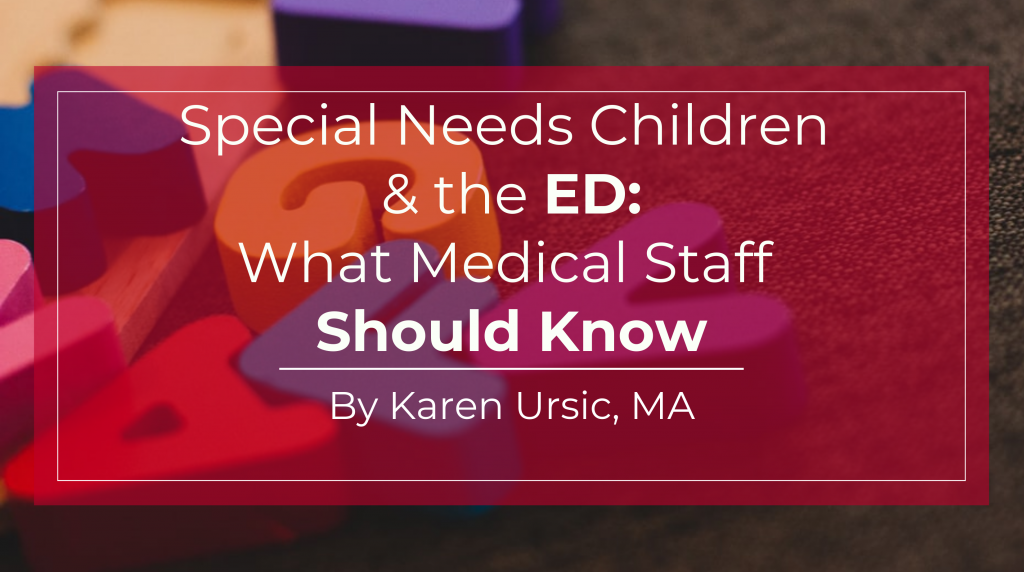by By Karen Ursic, MA
The parents of children with special needs can be a wealth of information and valuable perspective. Learn from those with boots-on-the-ground experience in order to provide the best possible care.
What are your thoughts?
I am a mother of three children, two of whom are on the autism spectrum and one who has type one neurofibromatosis (NF1). Most of what I have learned about their conditions is through lived experience. I also work part-time in the medical field, not as a doctor or nurse, but my job often brings me in contact with patients and has shown me that a little common sense and empathy goes a long way, no matter what my training or education is. It is in this spirit that I hope you find this information helpful, and are prepared to treat special needs children and successfully work with their parents and caregivers.
-
Under no circumstances should you belittle the parent, unless it is a clear case of neglect. I am sure that you think this goes without saying, but it still absolutely needs to be said. You went into the medical profession by choice, yet we parents did not directly volunteer to live this condition. We need your empathy and patience, not questioning as to why we did or did not do something a certain way or within a particular time frame. People with autism, for instance, can have a high threshold for pain or are not adept at communicating any adverse issues, even as adults, which may result in delaying seeking care or not understanding the severity of an issue.
-
If you are unfamiliar with the child’s medical condition, do not be afraid to get information from the parent. My youngest child has a neurological condition that less than two million people worldwide (less than 3% of the human population) have: type one neurofibromatosis (NF1). In my experience dealing with the doctors at Akron General and Akron Children’s pediatrics, most of the doctors are well educated about NF. Still, many in this country are not. While there is no need for you to admit complete ignorance, even if that is the case, use that as a moment to channel what you do know and simultaneously learn from the parents and what they know.
-
Alternatively, even if you are very familiar with and comfortable with a certain condition, keep an open mind and be willing to learn more. Listen to us parents. We don’t have the medical expertise that you do, but we have 24/7 lived experience. I know my children better than anyone else and even I learn new things about them every day. A saying that we have in the autism community is, “If you know one person with autism, that means you know one person with autism.” Patients, as people, definitely apply to this principle. While disabilities and conditions have certain common characteristics, every person who has them is an individual. Parents and caregivers are uniquely positioned to understand the nuances of each child and how their disabilities manifest.
-
Consider that some parents, or someone accompanying the patient to the ED, may have special needs themselves. You mustexercise patience, especially if the parent is in shock. For example,autism and neurological issues are inherited in my family, and have always suspected I am on the spectrum and am ADHD myself. I am an intelligent, capable person who always excelled in school, but personal communication, particularly in an emergency, is unscripted for me and therefore makes it difficult for me to process what you are saying about my child or asking from me.
-
If you send medication or instructions home with the patient, keep in mind that special needs people may need more visual and auditory information than others. For instance, if you send literature or instructions home with the patient, it can still be laden with jargon that a person with no medical background may not completely understand. Therefore, be willing to write some information in such a way that is easier to read. Perhaps you could develop a closed YouTube channel for videos on how to deal with certain aspects of a patient’s treatment once the ED visit is over. Better yet, demonstrate anything that could be helpful.
-
Nonverbal communication is still communication. If you have a nonverbal patient, please do your best to respect that person by still interacting with them and asking them questions. They can still respond. If a parent, family member, or whoever accompanies the patient to the ED needs to help translate responses then so be it, but never assume that you cannot interact with the nonverbal person.
-
Sensory issues are the biggest trigger for my children, as well as many children with special needs. An ED atmosphere can be loud and confusing, so try to make the waiting areas as soothing and quiet as possible. You should also avoid harsh lighting when possible. Things like certain smells, lights, and the tones of people’s voices can send my children with autism into a full meltdown. This is traumatizing and potentially dangerous for everyone involved. For these reasons, staffshould have every right to ask people in the waiting area to tone down their noise or be respectful of others around them.
This article was originally published in the July 2019 edition of The Pulse.


Leave A Comment
You must be logged in to post a comment.